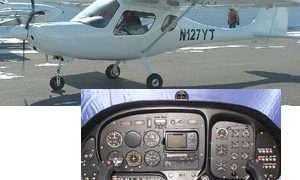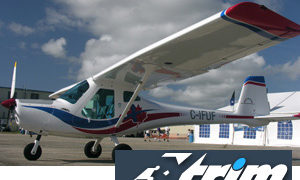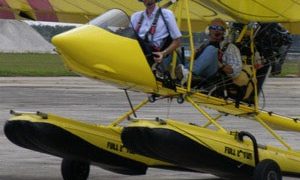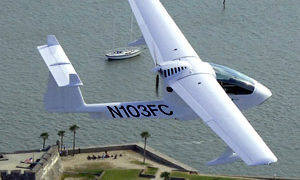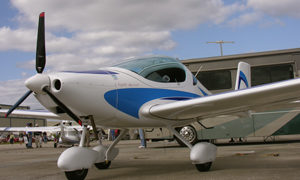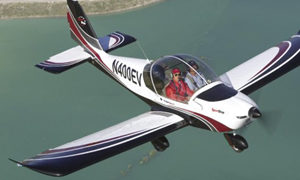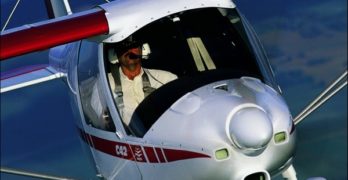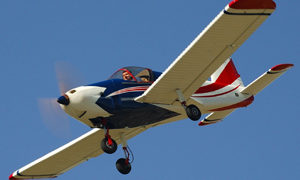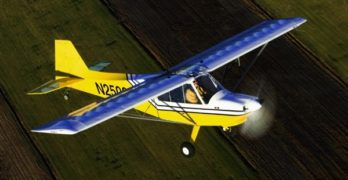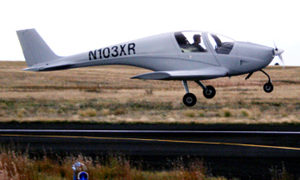Michigan-based Prestige Aircraft recently rolled out their first U.S.-built Storm Rally. Examples of this attractive high wing aircraft seen at airshows like AirVenture 2006 were manufactured by the Italian company that created the design. Now, Prestige builds the Rally under an agreement with Storm Aircraft and plans to add the low wing Century and amphibious Sea Storm in the future. *** Rally, which won its SLSA approval in early 2006, is a carbon fiber and Kevlar reinforced composite design that comes equipped with basic flight instruments and equipment for VFR day operation including a turn-coordinator; tail-strobe; ICON 200 radio; and Garmin transponder with an altitude encoder. Unlike many other brands, national distributor Air Elite Aviation says, “All aircraft models come with a limited two-year, or 1000-hour warranty.” Rally can cruise at 107 knots (75% power) and, with 34 gallons of usable fuel, it boasts an 800 nautical mile range.
Search Results for : flight design ct
Not finding exactly what you expected? Try our advanced search option.
Select a manufacturer to go straight to all our content about that manufacturer.
Select an aircraft model to go straight to all our content about that model.
Delightful-to-Fly Light-Sport Aircraft from Poland
Much attention on LSA seems to focus on U.S.-built aircraft or those from Czech Republic. Of course we have many other countries contributing to the growing U.S. fleet including Germany, Italy, and Australia. While Poland also contributes fabrication to the German-designed FK Lightplane series, the country isn’t widely known to Americans as an LSA provider. Its fuselage boom with vertical flanges (assembled from two fuselage halves) shows how this airplane descends from sailplane gliders built for many years in Eastern Europe. Imported by Rainbow Sport Aviation in Canada, the creator of the 3X55 is Adam Kurbiel, who designed gliders at the SZD-PZL glider factory before turning his attention to light airplanes. A modest cruiser (88 knots or 101 mph at 75% power), 3X55 handles beautifully and lands easily. The 47-inch-wide interior is nicely appointed with modern controls to match more expensive aircraft. Priced at $73,500 with the 80-hp Rotax, 3X55 seems a relative bargain.
Lockwood Delivering Drifter Kits; Air Cam Coming
When I first met Phil Lockwood, he was selling Drifters. That was more than 20 years ago. In that time the venerable Drifter ultralight went through several owners and many changes. A Drifter model even hailed from Australia for a time. But in a combined deal including the Air Cam — which Phil designed — all design rights, inventory, tooling, documentation returned home…to Lockwood enterprises (Read July 5, 2006 SPLOG). A 7,000 square-foot addition enlarges Lockwood’s facility to house the new activity. On a tour of this facility after the Sebring Expo I saw the stockpile of components that demanded a new building. Initially Phil expected only to supply Drifter parts to service about 1,000 aircraft flying around the globe. But early demand has staffers shipping a few kits even while they complete the factory. Lockwood also plans to deliver full Air Cam kits bringing this hugely delightful aircraft back to regular production.
LSA Aero Wins #2 FAA Amphib Exemption
Perhaps it’s a little ironic that Freedom wins its freedom. When I spoke with importer Don Langford at the Sebring LSA Expo he sounded somewhat unsure about the future for his Spanish amphibian. He’d submitted information for an exemption but had no reply. Yet shortly after Expo ended FAA granted LSA Aero‘s request for the Colyaer Freedom S100. The exclusive club now includes Czech Aircraft Works’ Mermaid and the Freedom. *** Each person exercising Sport Pilot privileges is required to obtain additional ground and flight instruction — on landing gear inspection, operation, and emergency procedures to include six takeoffs and landings and three in-flight gear movements. After a logbook endorsement and with appropriate placards on the aircraft, a Sport Pilot is allowed to move the gear as designed. Congratulations to Don and LSA Aero. This may help crack the door open wider for other amphibious LSA.
A Mystique, Yes; But Not a Mystery
LSA America is a newly formed company separate from but associated with Fantasy Air USA, importer of the very successful Allegro*. The new company displayed their Mystique from Flying Machines, which won SLSA #46 just before the Sebring LSA Expo. This lovely bird has smooth flowing lines all the way to a squared off vertical stabilizer. I took a test flight in Mystique to find a light handling airplane with huge visibility. Built in the Czech Republic, Mystique joins Interplane’s Skyboy in LSA America’s lineup. Mystique has a contemporary appearance and equipment neatly fitting the LSA mold and looks second generation compared to the low-cost Skyboy. Look for my report in EAA Sport Pilot soon (perhaps the March or April 2007 issue). On less than 26 feet of span, Mystique boasts a 15:1 glide; such performance is hard to judge in an hour flight but clearly Mystique held energy well.
Evektor Introduces Sportstar Plus at Sebring
Evektor America requested their Czech supplier, Evektor Aerotechnik to perform an engineering study of the design. The result? By slightly raising the stall speed to ASTM standards (45 knots), the company was able to add 55 pounds of useful load. The newly capable model will be called the Sportstar Plus. *** On a visit to their Kerrville, Texas base (the same city/airport that is home to Mooney Aircraft), Evektor America‘s Jeff Conrad also told me that deliveries have now exceeded 42 Sportstars and that the importer plans to bring in 60 aircraft for 2007, growing steadily to over 100 units by 2008. Evektor’s surprising success has been in the GA flight school market where they currently have 15 schools using 18 Sportstars. “We believe this is the best penetration of any SLSA,” said Jeff. *** In addition to having the first certified LSA Sportstar, Evektor America is gearing up to sell Evektor’s four seat Cobra model, to be certified under Part 23 regulations.
C42…An Ideal Light-Sport Aircraft Trainer?
Germany’s most popular microlight flies to America
Some readers and enthusiasts are excited about the proposed sport pilot/light-sport aircraft rule, while others have taken a wait-and-see approach. Virtually all recreational pilots are full of anticipation and questions. In the meantime, aircraft developers are also preparing.
Of those aircraft likely to become new ready-to-fly light-sport aircraft (LSA), many hail from Europe because its microlight regulations are close to the expected definition of LSAs in the United States. Germany is home to many manufacturers that produce potential LSAs, including Comco Ikarus, makers of the C42 Ikarus. The company has produced more than 1,500 aircraft, of which more than 650 are the C42 model. It’s an aircraft that both general aviation and microlight pilots appreciate, noted by the fact that it is Germany’s best-selling microlight. Every year, the factory cranks out another 80 C42s.
The design was first produced in 1996. Rather than follow the design of the company’s older C22, which looks like a Flightstar II SL in its Fastback version, the C42 started fresh.
Sky Skooter Makes Two SLSA for IndUS
Dallas, Texas-based IndUS Aviation earned their second SLSA model approval with certification of the T-11 Sky Skooter. Powered by the four cylinder, 85-hp Jabiru 2200, Sky Skooter becomes the lighter sibling to the potent Thorpedo, which uses the 120-hp Jabiru 3300 on the same airframe. Compared to IndUS’s T-211 with the Continental O-200 engine, the smaller Jabiru saves 100 pounds. Fuel burn is stated as 4 gph at economy cruise. At the design’s birth in 1944, Sky Skooter was designed around a 50-hp Franklin engine. With the lighter engine, the 2006 Sky Skooter tips the scales at a modest “645 pounds empty,” commented Ram Pattisapu, owner of IndUS. That is less than most Light-Sport Aircraft and brings pleasant handling as I found in a short flight in the prototype Sky Skooter. I find it refreshing to see a company use a smaller powerplant and simpler aircraft. But I ask the same question as with the Skykits Savannah ADV: Is Sky Skooter a “new” model for our SLSA List?
Proven again: Rans’ newly approved S-7LS
You’ve probably heard the tongue-in-cheek expression, “No good deed goes unpunished.”
RANS President Randy Schiitter knows this saying in a way no other light-sport aircraft
(LSA) producer can. When the company’s S-7 Courier earned special light-sport aircraft
(S-LSA) approval on October 24, 2005, it was the second time this aircraft
was certificated as a ready-to-fly (RTF) airplane, after first being designed as a kit.
RANS earned Primary Category certification
for this aircraft, as the S-7C
model, 10 years ago when that FAA regulation
was the latest big thing in aviation.
It took the Kansas company years
to complete that certification process,
but the recreational pilot certificate and
Primary Category certification failed
to meet industry expectations. After
spending lots of time and money earning
that approval, RANS didn’t jump
on the LSA bandwagon immediately.
The S-7 Courier was the first twoseat
aircraft produced by RANS, dating
to 1985 when the first prototype flew.
Swoopy Nexaer LS1 Takes to the Air
On October 16th, Nexaer took a first flight in their new LS1, an LSA designed precisely for Sport Pilot. Lifting off at Meadow Lake Airport in Peyton, Colorado, test pilot Bill VonDane followed a conservative test plan of crow hopping just a few feet above the runway, setting back down on the far end. Nexaer boss Paul Klahn plans to show the new model in the LSA area of AOPA Expo in Palm Springs Nov. 9-11. *** LS1 grosses at 1,320 lbs., has a 750-lb. empty weight (depending on options), 27 gallons of fuel, and each seat is a generous 21 inches wide. Nexaer says engine choices include two Jabiru models, Rotax 912, Continental O-200, or Lycoming O-235 (though the latter may cut useful load). LS1 is described as a “no-flap design for…reduced pilot workload.” Dual full controls are available, but standard left-seat-only controls produce an interior more closely resembling an automobile.
- « Previous Page
- 1
- …
- 124
- 125
- 126
- 127
- 128
- …
- 145
- Next Page »


